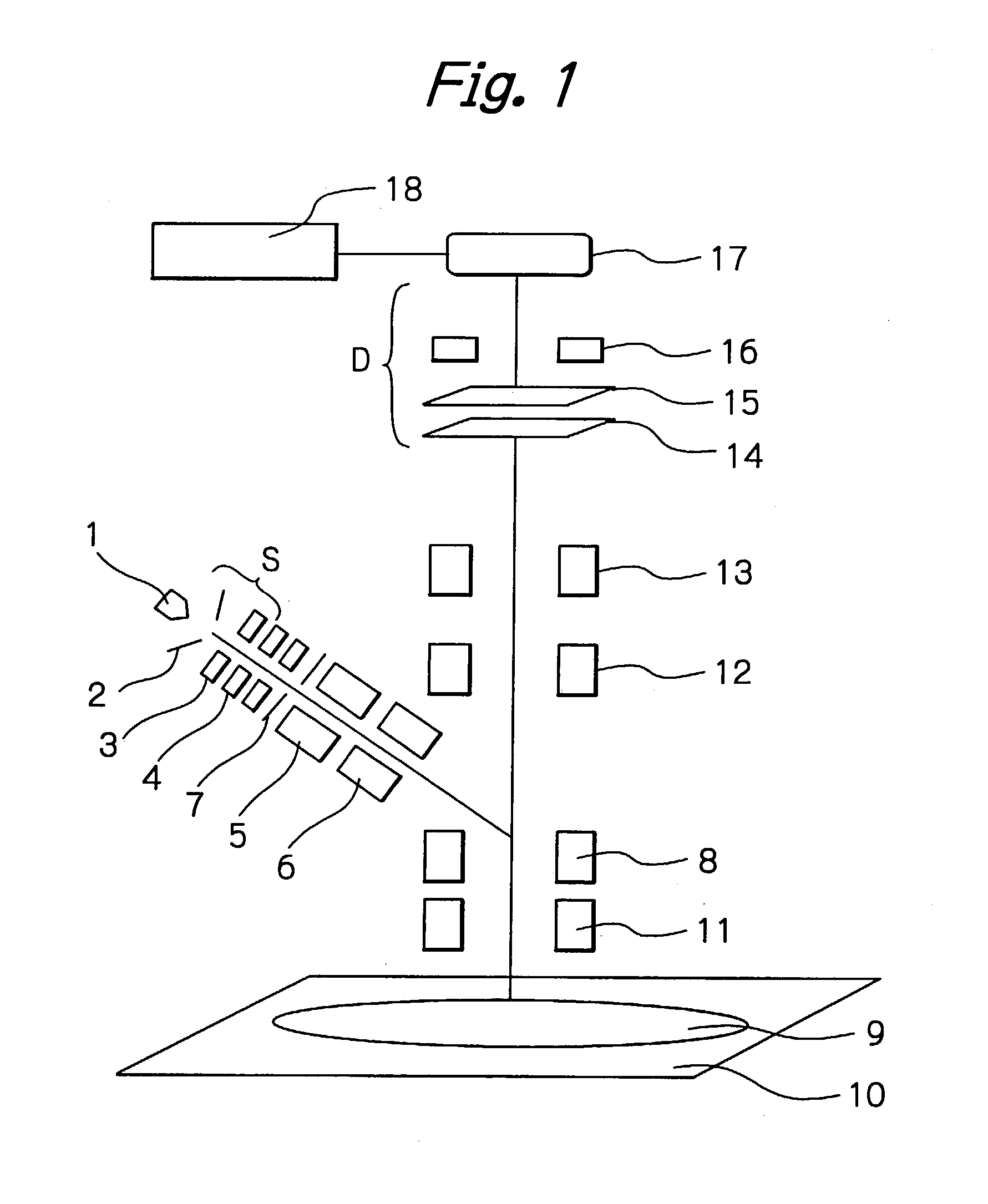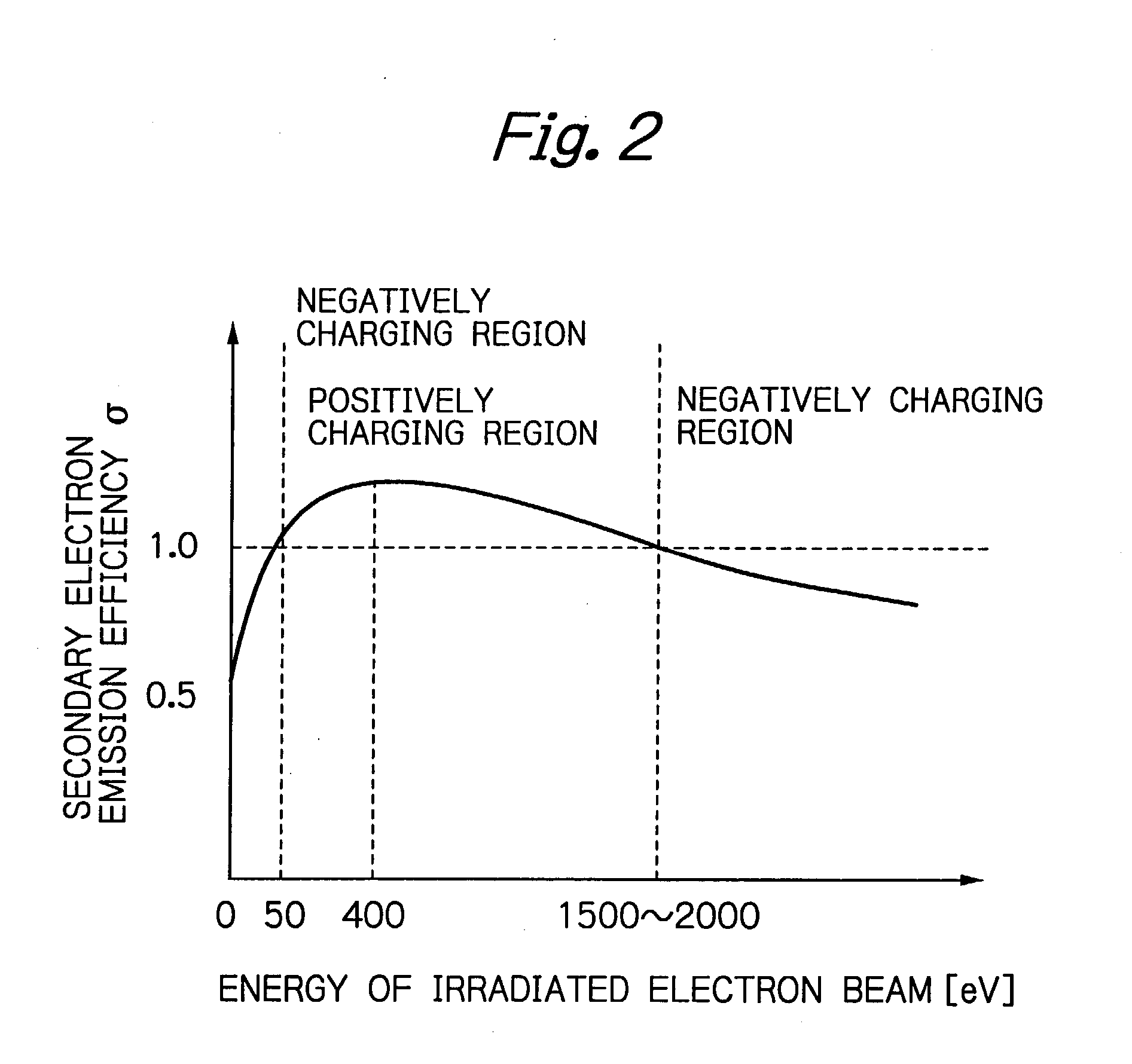Electron beam apparatus and device manufacturing method using same
- Summary
- Abstract
- Description
- Claims
- Application Information
AI Technical Summary
Benefits of technology
Problems solved by technology
Method used
Image
Examples
first embodiment
[0028] In the following, several embodiments of an electron beam apparatus according to the present invention will be described in detail with reference to FIGS. 1 to 8. FIG. 1 generally illustrates an electron beam apparatus according to the present invention. The illustrated electron beam apparatus comprises an electron source S which has a cathode 1, a Wehnelt electrode 2 and an anode 3. A primary electron beam emitted from the electron source S is enlarged by three electrostatic lenses, 4, 5, 6, and reshaped by a square aperture plate 7 such that its cross section is formed into a square. The primary electron beam thus reshaped travels in a direction which is bent toward a sample 9 by an ExB filter 8. In this way, the primary electron beam is controlled in terms of an area of the sample 9 irradiated therewith, and irradiation energy, and is irradiated to the sample 9 with a beam of 50 .mu.m.times.200 .mu.m and irradiation energy of 3 keV. The sample 9 may be a silicon wafer havi...
second embodiment
[0035] The second electron source S' suitable for use in the second embodiment may comprise a tungsten filament type hot cathode source or a carbon nanotube type cold cathode source, a Wehnelt electrode 2 and an anode 3 in this order. Using nanotube could achieve a process without heat damage by filament heating. With this second electron source S', the primary electron beam can provide an irradiation region of 10 .mu.m to 10 mm, for example, on the surface of the sample 9 by use of an aperture plate 7 for forming an irradiated area, in which case the irradiation energy can be controlled in a range of 0 to 4 keV, more preferably in a range of 2 to 4 keV.
[0036] FIG. 4 generally illustrates a third embodiment of the electron beam apparatus according to the present invention. As compared with the first embodiment illustrated in FIG. 1, the third embodiment differs in that a laser light source is provided in addition to the electron source S. The following description will be centered o...
third embodiment
[0038] The laser light source L used herein may be, for example, an He--Cd laser which preferably emits laser light at two wavelengths below 500 nm, specifically at 325 nm and 420 nm, and has an irradiation intensity of 2 W / cm.sup.2 or less, more preferably 1 W / cm.sup.2 or less, and an irradiating area of 1 mm in diameter. While the third embodiment illustrated in FIG. 4 employs only one laser light source, a plurality of laser light sources may be provided to irradiate the sample 9 with laser light emitted therefrom for increasing the irradiation intensity. Alternatively, the sample 9 may be irradiated with laser light from a plurality of laser light sources in symmetric directions to increase the efficiency.
[0039] FIG. 5 generally illustrates a mapping projection type inspecting apparatus which is a fourth embodiment of the defect detecting apparatus according to the present invention, where components identical or similar to those in the first embodiment illustrated in FIG. 1 are...
PUM
 Login to View More
Login to View More Abstract
Description
Claims
Application Information
 Login to View More
Login to View More - R&D
- Intellectual Property
- Life Sciences
- Materials
- Tech Scout
- Unparalleled Data Quality
- Higher Quality Content
- 60% Fewer Hallucinations
Browse by: Latest US Patents, China's latest patents, Technical Efficacy Thesaurus, Application Domain, Technology Topic, Popular Technical Reports.
© 2025 PatSnap. All rights reserved.Legal|Privacy policy|Modern Slavery Act Transparency Statement|Sitemap|About US| Contact US: help@patsnap.com



